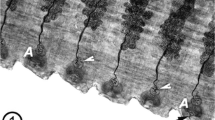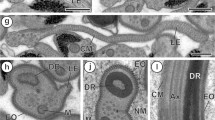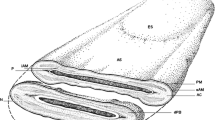Summary
The paired prominent ejaculatory ducts of the hermaphroditic polychaete Microphthalmus cf. listensis are surrounded by gland cells the processes of which penetrate the ducts themselves. These cells produce, in separate regions, two different types of spherical granules. Type I is composed of an electron dense and an electron lucent part. Type II granules contain a tubular filament that forms a single or double spiral in the periphery of a more or less unstructured electron dense material. Golgi vesicles give rise to this granule type. During the passage of sperm, these granules are obviously discharged into the lumen of the duct. Here they change form and probably dissolve. Their function is as yet unknown; capacitation of sperm is assumed.
Similar content being viewed by others
References
Alikunhi, K.H.: A new hermaphrodite species of Microphthalmus (Polychaeta Hesionides) from the sandy beach, Madras. J. Roy. Asiat. Soc., Sci. 14, 17–25 (1948)
Bobretzky, N.: Zur Lehre über die Fortpflanzungsorgane der Anneliden. [In Russian] Kiev Odschest. Est. Zap. 6, 61–86 (1880)
Ermak, T.H., Eakin, R.M.: Fine structure of the cerebral and pygidial ocelli in Chone ecaudata (Polychaeta: Sabellidae). J. Ultrastruct. Res. 54, 243–260 (1976)
Richards, K.S.: The histochemistry and ultrastructure of the clitellum of the enchytraeid Lumbricillus rivalis (Oligochaeta: Annelida). J. Zool., Lond. 183, 161–176 (1977)
Rieger, R.M., Ruppert, E.: Resin embedment of quantitative meiofauna samples for structural and ecological studies. — Description and application. Mar. Biol. 46, 223–235 (1978)
Storch, V., Welsch, U.: The ultrastructure of epidermal mucous cells in marine invertebrates (Nemertini, Polychaeta, Prosobranchia, Opisthobranchia). Mar. Biol. 13, 167–175 (1972)
Threadgold, L.T.: The ultrastructure of the animal cell. 2d ed., pp. 514. Oxford: Pergamon Press 1976
Westheide, W.: Monographie der Gattungen Hesionides Friedrich und Microphthalmus Mecznikow (Polychaeta, Hesionidae). Ein Beitrag zur Organisation und Biologie psammobionter Polychaeten. Z. Morph. Tiere 61, 1–159 (1967)
Westheide, W.: Zwei neue interstitielle Microphthalmus-Arten (Polychaeta) von den Bermudas. Mikrofauna Meeresboden 14, 1–16 (1973)
Westheide, W.: Ultrastructure of the genital organs in interstitial polychaeta. I. Structure, development, and function of the copulatory stylets in Microphthalmus cf. listensis. Zoomorphologie 91, 101–118 (1978)
Westheide, W.: Zur Ultrastruktur der Genitalorgane in interstitiellen Polychaeten. II. Männliche Kopulationsorgane mit intracellulären Skelettstäben in einer Microphthalmus-Art. Zool. Scr. (in press) (1979)
Westheide, W., Rieger, R.M.: Cuticle ultrastructure of hesionid polychaetes (Annelida). Zoomorphologie 91, 1–18 (1978)
Author information
Authors and Affiliations
Rights and permissions
About this article
Cite this article
Westheide, W. Unusual granules in the ejaculatory duct of a Microphthalmus species (Polychaeta, Annelida). Cell Tissue Res. 197, 61–68 (1979). https://doi.org/10.1007/BF00233553
Accepted:
Issue Date:
DOI: https://doi.org/10.1007/BF00233553




